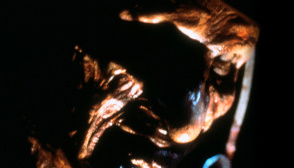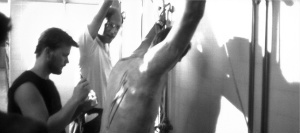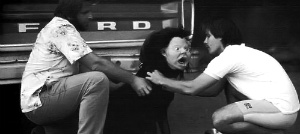
Director: Jack Sholder
Writer: David Chaskin
Starring: Mark Patton, Kim Myers, Robert Rusler, Clu Gulager
Up until 1984 the slasher genre had been owned by Jason Voorhees. Despite the cycle being kickstarted by Halloween in 1978, Michael Myers had enjoyed two outings before being absent from the third entry, but Friday the 13th‘s resident antagonist had grown from strength to strength. But the surprise success of A Nightmare on Elm Street had given Paramount‘s iconic monster a run for his money and cult filmmaker Wes Craven had introduced horror fans to a new villain… Freddy Krueger. The movie had cemented the reputation of New Line Cinema and had helped breathe life back into the slasher formula, so it was inevitable that a sequel would soon follow. In fact, producer Robert Shaye had insisted on a ridiculous epilogue to be tagged onto the end of Craven’s piece in order to allow for further installments and once the box office returns had been tallied a sequel was greenlit. And with Jason having claimed to have delivered his Final Chapter, the studio wasted no time in attempting to fill the void left by Friday the 13th and began work on A Nightmare on Elm Street 2.
Naturally, Shaye’s first intention is to bring back Craven to once again direct the feature. Despite feeling a loyalty towards the producer who had agreed to find his project, Craven expressed concerns over the story that had been pitched to him and eventually declined. His issues involved the decision of bringing Freddy out of the protagonist’s dreams and into the real world, no longer stalking the children of Elm Street and instead attempting to possess the teenage boy who had recently moved into Nancy’s old home. But Craven had been forced to sell his rights to the character in order to pay his debts during the making of the first film and so Shaye had the freedom to continue without the input of the director. The script itself was penned by David Chaskin, a graduate of the New York Institute of Technology and the State University of New York who had worked in film distribution before turning to writing with the comedy The Monster from Out of Town and the drama Hard Rock Highway, which brought him to the attention of New Line.

Although he would play no part in the making of the movie, Craven did offer Chaskin some suggestions regarding his script, most notably the focus of the story which had mainly concentrated on its tortured hero, Jesse. Craven had advised the young writer to shift the attention halfway through to his girlfriend, Lisa, and tell the rest of the story from her point of view. He also stated that having the action during the climax take place in a confined environment would be more effective than out in the open, thus resulting in the last reel being set at an old industrial site where Freddy had taken his young victims. But, unimpressed with the studio’s intentions for the movie, Craven would distance himself from the project and instead write and direct his own critically mauled sequel The Hills Have Eyes Part II. With Craven out of the picture, Shaye was forced to search elsewhere for a suitable replacement, someone who would not only be able to handle the elaborate special effects which Chaskin’s script would demand but also the teen angst drama which was at the heart of the story.
Enter Jack Sholder, a filmmaker with a long history at New Line Cinema. Born on June 8 1945 in Philadelphia, Pennsylvania, Sholder spent his youth as a trumpet player in school orchestras. His first career as an engineer resulted in a placement at the Drexel Institute of Technology in his home town, which would eventually earn university status in 1970. but soon Sholder was inspired to study film and, in 1964, enrolled at Antioch College where he began making short films, with his first effort, Diary, attracting the attention of Paul Gurian, a young wannabe producer. Together they developed The Garden Party for PBS in 1973, a twenty-five minute short which led to a Special Jury Award at the San Francisco Film Festival. After spending three years in pre-production on Outlaws, based on a script by Sholder, he continued to write various obscure screenplays including Barnum and Golden Honeymoon, whilst also forging a career as a successful editor, cutting such cult favourites as the Sonny Chiba flick Gekitotsu! Satsujin ken (aka The Street Fighter) for Shaye, who planned to distribute Asian movies in America. When New Line decided to make the leap into production, Sholder was the obvious choice for their first feature, Alone in the Dark, which he would co-write along with Shaye and Michael Harrpster. Meanwhile, he continued his career as an editor by collaborating with Miramax on their debut The Burning.

With casting underway, New Line were able to once again secure the services of actor Robert Englund, who had enjoyed minor success after A Nightmare on Elm Street as the lovable alien Willy in the hit sci-fi show V. With Freddy in place, Shaye and Sholder began searching for their young hero, who would replace Heather Langenkamp’s Nancy as the film’s central character. After auditioning such future stars as Christian Slater and Brad Pitt, the filmmakers eventually settled on twenty-one year old Mark Patton, a native of Riverside, Missouri, who had previously enjoyed acclaim on Broadway in Robert Altman’s Come Back to the Five n’ Dime, Jimmy Dean, Jimmy Dean. Legend has it that Patton had originally tried out for the role of Glen Lantz in the first A Nightmare on Elm Street but had lost the part to an inexperienced Johnny Depp. His co-star and on-screen girlfriend was Kim Myers, who had returned to Los Angeles after completing her first year at Syracuse University. Two years younger than Patton, her only prior acting experience was a USC student, One Southern Summer.
With a budget of approximately $3m, almost twice the amount of the first film, principal photography commenced on June 26 1985 for almost two months. The house used for the location of 1428 Elm Street would be the same one that Craven had filmed in on North Genesee Avenue, West Hollywood, whilst the sequence at the boiler room in which Lisa would be forced to face-off against Freddy was shot at California Steel Industries, Inc. in Fontana, California. For his crew, Sholder enlisted a variety of talented artists, resulting in one of the strongest assemblies of the entire series. For the eerie score, the filmmakers had chosen Christopher Young, a UCLA graduate who had made his feature debut composing music for the student film The Dorm That Dripped Blood, which would eventually make its way onto the UK’s ‘video nasty’ list under the alternative name Pranks. The cinematography would be handled by Jacques Haitkin, who had lensed the original.

A Nightmare on Elm Street Part 2: Freddy’s Revenge would open with one of the most memorable sequences of the franchise, with the neurotic Jesse taking the bus to school, when suddenly the driver is revealed to be Freddy. Englund himself drove the bus during this scene and played the driver, albeit without his trademark makeup. One of the young victims on the bus was portrayed by Joann Willete, who would later enjoy a regular spot on the ABC sitcom Just the Ten of Us alongside Langenkamp. Another key scene would be found later in the film, when Freddy gatecrashes a pool party and begins to slice his way through the guests. Unable to control himself from laughing during a shot in which a prosthetic tongue was to reach out of Jesse’s mouth onto Lisa’s chest, Sholder was forced to remove himself from the director’s chair and hand over the reigns to his assistant director.
The highly impressive special effects and transformation sequences were handled by renowned artist Kevin Yagher, who had previously worked alongside the legendary Tom Savini on Friday the 13th: The Final Chapter and would work on not only the subsequent two A Nightmare on Elm Street movies but also the small screen spin-off, Freddy’s Nightmares. But, despite the gruesome set pieces, when Freddy’s Revenge was released in America on November 1 1985, it was greeted by criticism from fans who were disappointed that the filmmakers had tried to change the formula too much and ignored the rules laid out by Craven’s film. Later on, events would take an even more bizarre turn when critics began to accuse the movie of being either homoerotic or homophobic, due to its effeminate protagonist, the S&M-loving coach and the concept of Freddy attempting to ‘possess the body’ of the hero, instead of just slaughtering him like he would usually do. Both Sholder and Chaskin would later dismiss this as unintentional but the film still remains one of the least popular of the series.


12 Responses to NEVER SLEEP AGAIN – A Nightmare on Elm Street Part 2: Freddy’s Revenge (1985)